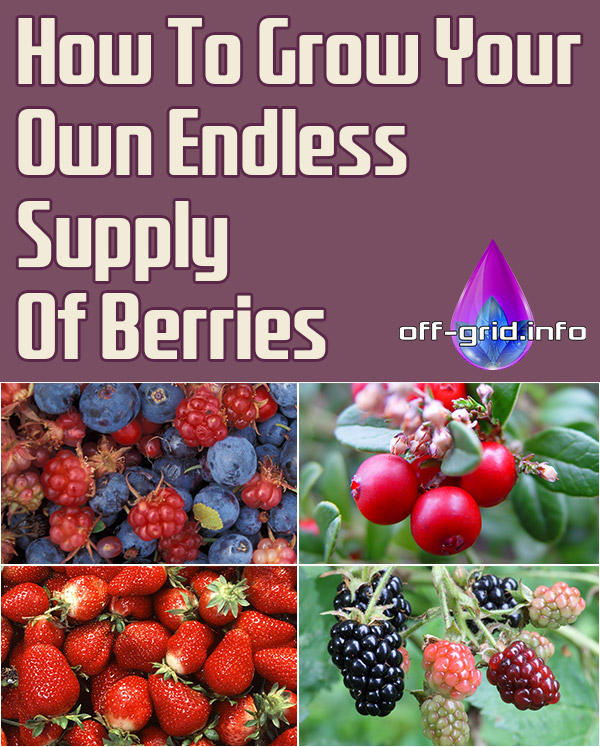Click Here To Join Our Telegram Channel for FREE daily tutorials!

Graphic – off-grid.info. Images – Wikipedia – 1 2 3 4 – lic. under Creative Commons
Growing berries is one of the easiest ways to produce nutritious home grown food! If you’ve ever found wild strawberries or blackberries you will realize that these plants will generally produce fruit without our intervention. However, certain techniques will help you get the best crops.

Many fruit bushes are hardy and tolerant to a variety of soil conditions – once they are established, they will need very little maintenance and will supply you with delicious berries for many years. Don’t worry if you have only a small yard or patio – soft fruit is well suited to container growing!
You will also quickly notice that humans aren’t the only creatures that enjoy berries – and it is likely that you will require netting to keep birds off strawberries and raspberries.
It could take a few years to establish a fruit garden to provide enough produce to last all year round, but before you go out and buy your plants, take a moment to find out which ones will grow best in your climate and if they require any special treatment – consider the size of the full-grown plants, soil type, pH, moisture levels and amount of sun required. We will focus on those that grow well in a temperate climate… so let’s look at how to grow some of the more common berries and a few of the unusual ones!
Strawberries: Strawberries are easy to grow, preferring a sunny location. Each plant will bear runners that can be separated and planted in a new plot after three or four years – this helps to prevent disease. Add a mulch of straw when the fruits first develop to keep them clean, or grow them through plastic sheeting. They like a well-drained, fertile soil. If you have very little space for planting, please check out this easy tutorial for a DIY strawberry tower!
Blackberries: You might be lucky enough to find a good crop of wild blackberries near your home but be wary of blackberries in “civilization” as they might be contaminated by traffic pollution, chemical sprays or even polluted soil. It’s always worth learning about the history of the place you are foraging from…. Fortunately, blackberries are easy to grow at home. If anything, they are too easy and the main goal is to keep them from going crazy! There are thornless varieties available that produce large fruits on the one year old stems – annual pruning in the fall is necessary to remove the stems that have finished fruiting. Tie up the new stems to wires or trellis to keep them tidy and off the ground.
Raspberries: Raspberries, Tayberries, Boysenberries (less cold-tolerant) and Loganberries are all very similar in growth and requirements. There are two main types of raspberries; summer- and autumn-fruiting. Prune summer varieties in the fall and autumn-fruiting ones in late winter – new stems need to be tied up to a trellis or wires every year.

Blueberries: Blueberries are very hardy but need an acid soil, with a pH of 5.5 or less so you will need to add sulphur chips or used coffee grounds to a neutral soil before planting – they would be ideal for growing in containers as acidic (ericaceous) soil can be used. They also need damp ground – why not try growing them in a old bath tub (with the plug out!) or similar large container buried in the garden! This allows for good water retention in the soil.
Gooseberries: These are very hardy plants that need only an occasional mulch and a yearly trim to keep their shape – aim for an open “goblet” shape to allow light and air to circulate and to improve pollination.
Blackcurrants: These are classified as berries and are closely related to gooseberries – they can grow in partial shade and prefer a damp, fertile soil, being drought intolerant. They require a soil acidity level around pH6. Regular mulching is helpful to keep competitive weeds at bay – grass cuttings are good as long as they are not applied in contact with the stems. Pruning is done in late fall to late winter to remove old or weak wood and to maintain a goblet-like shape. Blackcurrants are very versatile in cooking, they are high in pectin so make an easy jam or jelly (also good to add to other fruit to help with setting) and provide a great source of Vitamin C and anthocyanins! Redcurrants and Whitecurrants are very similar to grow and add some colour and variety to your diet!
Goji berries: There is one available variety of this Superfood berry and it is surprisingly easy to grow at home if you have a sunny area! Goji bushes need a well-drained compost-enriched soil and pruning in early spring. They grow best when trained against a wall or fence. They are a great choice for a coastal garden because they are tolerant to salt-laden air.
Most berries have a short cropping season so in order to enjoy them all year round, you will need to look at ways to preserve them. A deep freeze is probably the simplest solution and it is a surprisingly good method for retaining vitamins and health-giving phytonutrients, especially in good quality, organically grown berries. For best results, the crop should be frozen as soon as possible after harvesting and in airtight food grade containers – the fruit will be good for up to 6 months.
Other methods include canning, bottling and making preserves – if the jars are well sterilised, these will keep for at least a year. I have made jam that has stored perfectly for 5 years although it’s so tasty that you may have to hide it for it to last this long!

Further resources:
http://www.whfoods.com/genpage.php?tname=george&dbid=215
http://www.uga.edu/nchfp/how/freeze.html
https://www.rhs.org.uk/advice/grow-your-own/fruit

This Crazy Off Grid Device Literally Makes Drinkable Water From Fresh Air:
According to NASA, the U.S. is expecting a 100-YEAR LONG MEGADROUGHT.
It's already begun. Ask the farmers in California. They know.
Every survivalist knows that water is of critical importance. You NEED an independent water source that you can count on!
As an interesting "survival rehearsal" - imagine that you turned the tap on right now and nothing came out. How long would you last?
But what if there was another water source literally hidden in plain sight. That's right, I'm talking about the atmosphere!
The amazing thing about getting water from the natural moisture in the air... is that it is ALWAYS available.
This gives you real water security!
Learn more about how to tap into "Nature's secret water reservoir" and stay hydrated when TSHTF!
Watch the video:
� What Tinnitus Does To Your Brain Cells (And How To Stop It)
After 47 years of studies and countless brain scans done on more than 2,400 tinnitus patients, scientists at the MIT Institute found that in a shocking 96% of cases, tinnitus was actually shrinking their brain cells.
As it turns out, tinnitus and brain health are strongly linked.
Even more interesting: The reason why top army officials are not deaf after decades of hearing machine guns, bombs going off and helicopter noises...
Is because they are using something called "the wire method", a simple protocol inspired by a classified surgery on deaf people from the 1950s...
Most People Don't Have The Guts To Try This:
An amazing discovery in an abandoned house in Austin, Texas: A lost book of amazing survival knowledge, believed to have been long vanished to history, has been found in a dusty drawer in the house which belonged to a guy named Claude Davis.
Remember... back in those days, there was no electricity... no refrigerators... no law enforcement... and certainly no grocery store or supermarkets... Some of these exceptional skills are hundreds of years of old and they were learned the hard way by the early pioneers.
>> Click here to find out about them now
We've lost to history so much survival knowledge that we've become clueless compared to what our great grandfathers did or built on a daily basis to sustain their families.
Neighbors said that for the last couple of years Claude has tried to unearth and learn the forgotten ways of our great-grandparents and claimed to have found a secret of gargantuan proportions. A secret that he is about to reveal together with 3 old teachings that will change everything you think you know about preparedness:
>> Click Here To Watch The Video <<
What REALLY Happens When You Bury a Shipping Container? (Hint: It's A Bit Crazy...)
Shipping containers are all the rage - but if you are thinking about buying one, you MUST watch this video first:
Do not, I repeat do NOT do what these lunatics did! Can you spot the "fatal mistake" they made?
There's a general belief that if you bury a shipping container you can create an awesome root cellar / storm shelter / survival bunker.
But is a shipping container strong enough to handle the pressure?
Watch the video to see what happens:
What Really Happens When You Bury a Shipping Container? (Click To Watch Video)

I Can't Help Showing This Off:
If you haven't heard of Claude Davis yet do yourself a huge favor and watch this video.
One of the smartest guys I ever had the pleasure of meeting, Claude set-up a unique prepping system that changed his life forever.
I already tried it myself and let me tell... you I was completely blown away... His surprising tactics could make your life easier and give you the peace of mind you deserve.
Don't just take my word for it... watch his short video and decide for yourself.
>> Click Here To Watch The Video <<

More Off-Grid And Survival Resources:













Awesomeness!
I bought 8 blackberry and 8 raspberry wines. I planted them next to a short section of chicken wire fence. I am going to put another fence section the same length about 2 feet away. I am doing that to let the berry vines grow across the tops of the fencing to the other side. This way I can pick from both sides and the top.